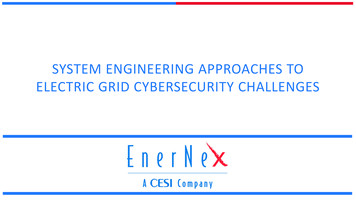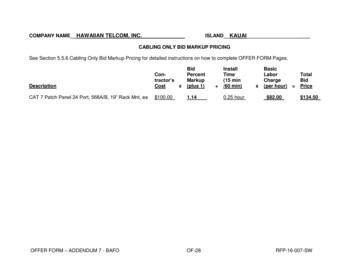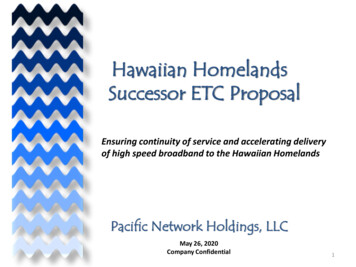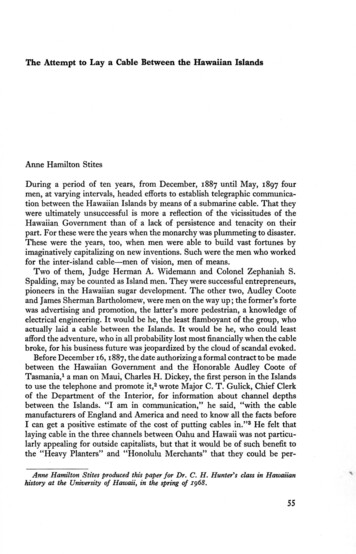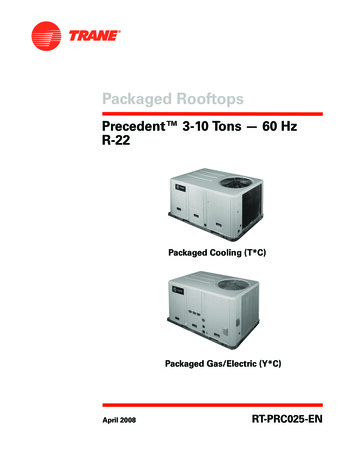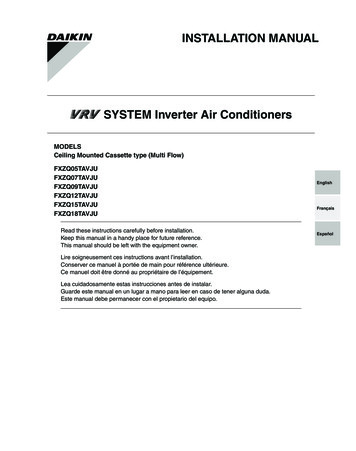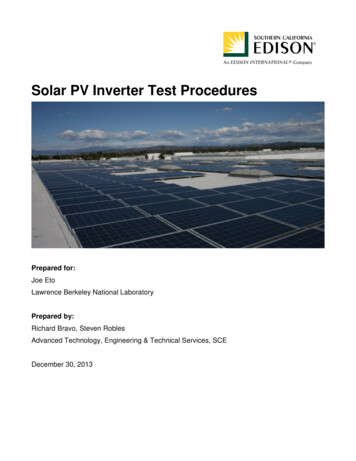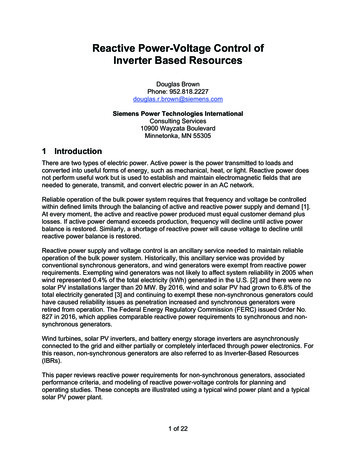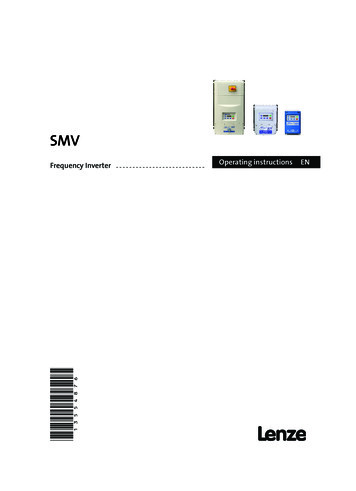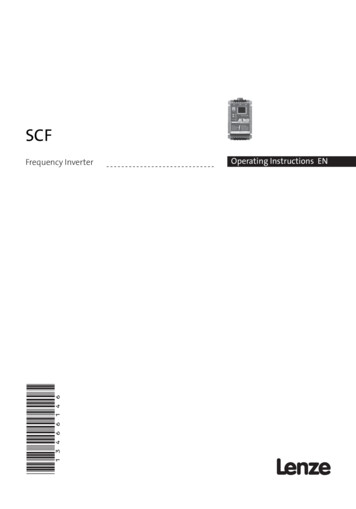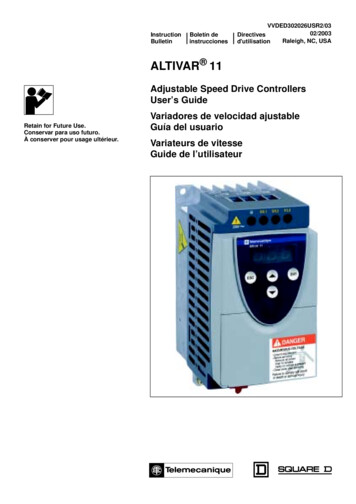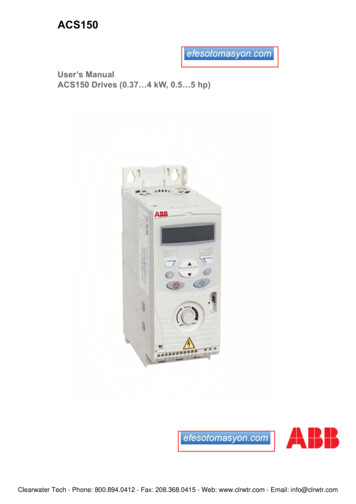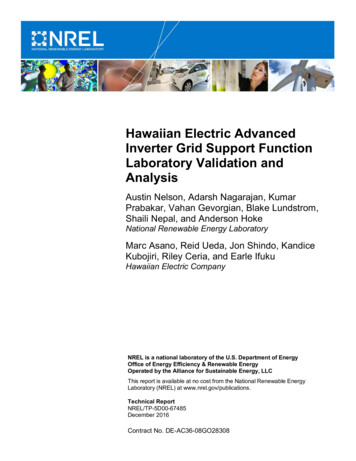
Transcription
Hawaiian Electric AdvancedInverter Grid Support FunctionLaboratory Validation andAnalysisAustin Nelson, Adarsh Nagarajan, KumarPrabakar, Vahan Gevorgian, Blake Lundstrom,Shaili Nepal, and Anderson HokeNational Renewable Energy LaboratoryMarc Asano, Reid Ueda, Jon Shindo, KandiceKubojiri, Riley Ceria, and Earle IfukuHawaiian Electric CompanyNREL is a national laboratory of the U.S. Department of EnergyOffice of Energy Efficiency & Renewable EnergyOperated by the Alliance for Sustainable Energy, LLCThis report is available at no cost from the National Renewable EnergyLaboratory (NREL) at www.nrel.gov/publications.Technical ReportNREL/TP-5D00-67485December 2016Contract No. DE-AC36-08GO28308
Hawaiian Electric AdvancedInverter Grid Support FunctionLaboratory Validation andAnalysisAustin Nelson, Adarsh Nagarajan, KumarPrabakar, Vahan Gevorgian, Blake Lundstrom,Shaili Nepal, and Anderson HokeNational Renewable Energy LaboratoryMarc Asano, Reid Ueda, Jon Shindo, KandiceKubojiri, Riley Ceria, and Earle IfukuHawaiian Electric CompanyPrepared under Task No. WTQE.1000NREL is a national laboratory of the U.S. Department of EnergyOffice of Energy Efficiency & Renewable EnergyOperated by the Alliance for Sustainable Energy, LLCThis report is available at no cost from the National Renewable EnergyLaboratory (NREL) at www.nrel.gov/publications.National Renewable Energy Laboratory15013 Denver West ParkwayGolden, CO 80401303-275-3000 www.nrel.govTechnical ReportNREL/TP-5D00-67485December 2016Contract No. DE-AC36-08GO28308
NOTICEThis report was prepared as an account of work sponsored by an agency of the United States government.Neither the United States government nor any agency thereof, nor any of their employees, makes any warranty,express or implied, or assumes any legal liability or responsibility for the accuracy, completeness, or usefulness ofany information, apparatus, product, or process disclosed, or represents that its use would not infringe privatelyowned rights. Reference herein to any specific commercial product, process, or service by trade name,trademark, manufacturer, or otherwise does not necessarily constitute or imply its endorsement, recommendation,or favoring by the United States government or any agency thereof. The views and opinions of authorsexpressed herein do not necessarily state or reflect those of the United States government or any agency thereof.This report is available at no cost from the National Renewable EnergyLaboratory (NREL) at www.nrel.gov/publications.Available electronically at SciTech Connect http:/www.osti.gov/scitechAvailable for a processing fee to U.S. Department of Energyand its contractors, in paper, from:U.S. Department of EnergyOffice of Scientific and Technical InformationP.O. Box 62Oak Ridge, TN 37831-0062OSTI http://www.osti.govPhone: 865.576.8401Fax: 865.576.5728Email: reports@osti.govAvailable for sale to the public, in paper, from:U.S. Department of CommerceNational Technical Information Service5301 Shawnee RoadAlexandria, VA 22312NTIS http://www.ntis.govPhone: 800.553.6847 or 703.605.6000Fax: 703.605.6900Email: orders@ntis.govCover Photos by Dennis Schroeder: (left to right) NREL 26173, NREL 18302, NREL 19758, NREL 29642, NREL 19795.NREL prints on paper that contains recycled content.
AcknowledgmentsThe National Renewable Energy Laboratory graciously thanks the Hawaiian Electric Companiesfor funding this work, providing technical expertise, and choosing NREL for collaboration onthis important topic.The authors would also like to thank the participating inverter manufacturers for their voluntarycontribution of test articles, collaboration, and technical expertise throughout the project. Theyinclude Apparent Inc., Enphase Energy, SMA America, and SolarEdge Technologies.In addition, the authors would like to express appreciation to the members of the Hawai‘i SmartInverter Technical Working Group for their valuable technical input and review.The volt-var control tests contained in this report were conducted with funding from the U.S.Department of Energy Solar Energy Technologies program. The authors are grateful to KemalCelik, Rebecca Hott, and Guohui Yuan from the DOE for their support.iiiThis report is available at no cost from the National Renewable Energy Laboratory (NREL) at www.nrel.gov/publications.
List of SSIASITWGSRDULUFRUVRVRTVVCVWCμsAlternating currentDirect currentElectromagnetic transientFeed-in tariffFixed power factorFrequency ride-throughGrid support functionHigh frequency ride-throughHardware-in-the-loopHigh voltage ride-throughInstitute of Electrical and Electronic EngineersKilowatt-hourLow frequency ride-throughLow voltage ride-throughManufacturing Alliance of Inverters TechnicalAssessment of Integration IssuesManufacturer’s stated accuracyNet Energy MeteringNational Renewable Energy LaboratoryNormal high operating region (per Rule 14H)Normal low operating region (per Rule 14H)Overfrequency ride through (per Rule 14H)Overvoltage ride-through (per Rule 14H)Power hardware-in-the-loopPhase locked loopReal and reactive powerPer unitPhotovoltaicResistive-inductiveRoot mean squareStandard Interconnection AgreementSmart Inverter Technical Working GroupSource Requirements DocumentUnderwriters LaboratoriesUnderfrequency ride-through (per Rule 14H)Undervoltage ride-through (per Rule 14H)Voltage ride-throughVolt-var controlVolt-watt controlMicrosecondivThis report is available at no cost from the National Renewable Energy Laboratory (NREL) at www.nrel.gov/publications.
Executive SummaryThe Hawaiian Electric Companies 1 sought the support of the U.S. Department of Energy’sNational Renewable Energy Laboratory (NREL) to assist the Companies’ efforts to meet theHawai‘i Public Utilities Commission (HPUC) Order 2 to collaborate with inverter manufacturersto develop a test plan for the highest priority advanced photovoltaic (PV) inverter functions thatdo not yet have Nationally Recognized Testing Laboratory certification to UnderwritersLaboratories (UL) Standard 1741. In the HPUC Order, the Companies were also directed to testa variety of advanced inverters to assess their performance with respect to the high priority gridsupportive functions for Hawai‘i’s operating requirements and to submit its findings to theHPUC.The Companies’ stated objectives for this test plan were to better understand how to utilize theperformance capabilities of advanced inverter functions to allow the interconnection ofdistributed energy resource (DER) systems to support the new Customer Self-Supply, CustomerGrid-Supply, and other future DER programs.The purpose of this project was to: 1) characterize how the tested grid supportive invertersperformed the functions of interest, 2) evaluate the grid supportive inverters in an environmentthat emulates the dynamics of O‘ahu’s electrical distribution system, and 3) gain insight into thebenefits of the grid support functions on selected O‘ahu island distribution feeders.The following four inverter manufacturer members from the Companies’ Smart InverterTechnical Working Group (SITWG) contributed inverter hardware and technical support fortesting under this project: Apparent Inc., Enphase Energy, SolarEdge Technologies, and SMAAmerica. A total of five inverters were tested: two models from Enphase and one model eachfrom the other three manufacturers. The Enphase inverters consisted of one “legacy” invertermodel (i.e. a model not capable of providing some or all of the grid supportive functionscontemplated by UL 1741 Supplement SA) and one model of grid supportive inverters. Theinverters from Apparent, SMA, and SolarEdge were all grid supportive models.The selection of grid supportive inverters represented a broad spectrum of technologies includingone split-phase residential-scale string inverter, assemblies of three types of microinverters, andone three-phase 480 V small commercial string inverter. The Companies expanded the scope ofinverter testing to include the Enphase legacy inverters in order to better characterize the baselineperformance of existing legacy PV systems since the Enphase legacy inverters have such adominate presence on the Hawaiian island grids.The Hawaiian Electric Companies tariff for Interconnection of Distributed Generating Facilitieswith the Company’s Distribution System (Rule 14H) defines a total of eleven grid supportivefunctions. Of the eleven functions, the Companies with input from the members of their SITWGidentified seven grid functions to be tested by NREL. The SITWG also provided NREL withHawaiian Electric Company, Inc.; Maui Electric Company, Limited; and Hawai‘i Electric Light Company, Inc. arecollectively referred to as the “Hawaiian Electric Companies” or “Companies”.2Order No. 33258, Docket No. 2014-0192, Instituting a Proceeding to Investigate Distributed Energy ResourcePolicies.1vThis report is available at no cost from the National Renewable Energy Laboratory (NREL) at www.nrel.gov/publications.
technical review and feedback on the test plan and testing requirements at various pointsthroughout the project.The seven grid support functions tested were: Fixed power factor operation Volt-watt control Volt-var control (baseline testing only) Voltage ride-through Frequency ride-through Ramp rate control Soft start reconnectionSome combinations of these functions were also tested simultaneously to the extent the specificinverter model was able to support the combined activation of functions.The tests conducted under this project fall into two categories. The first category, referred to hereas “baseline” testing, consisted of conventional lab testing, in which the input and outputterminals of the inverter under test were connected to DC and AC power supplies, the ACvoltage or frequency was varied systematically, or the available DC input power was varied, andthe inverter’s response was recorded. For the baseline tests, the test procedures were based on adraft version of the recently-published UL 1741 Supplement SA. The goal of testing was not tocertify inverters, but rather to characterize their responses for the grid support functionality. Atotal of over 238 baseline tests were performed across the five inverters.The second category of tests consisted of power hardware-in-the-loop (PHIL) tests, whichcoupled computer simulation with hardware testing. In the PHIL tests, real-time models of twoof Hawaiian Electric’s electrical distribution feeders were run, and the simulated voltage at adistribution secondary location was used to drive the voltage waveforms of an AC power supplyconnected to a PV inverter. The measured AC current from the inverter was fed back into thefeeder model, such that the inverter and the simulated distribution system were dynamicallyconnected. Thus the PHIL tests simulated placing the inverter under test on a real feeder. Inaddition to the hardware inverter, the simulated feeder contained many simulated legacy and gridsupportive PV inverters whose ratings were based on the inverters actually deployed (orexpected to be deployed) on the real feeder. The simulated grid supportive PV inverters emulatedthe behavior of the hardware inverters characterized in the baseline tests. This allowed the PHILtests to evaluate the impact of very large numbers of grid supportive PV inverters configured invarious ways performing the selected grid support functions. A total of over 250 PHIL tests wereperformed across four inverter models; the legacy Enphase inverters were not tested in PHIL.The PHIL tests simulated two O‘ahu island distribution circuits with high levels of legacydistributed rooftop PV (penetration levels of 88% and 140% of gross daytime minimum load asof the end of 2015). Scenarios reflecting Hawaiian Electric’s forecast of PV penetration by 2021were also tested in PHIL. Due to the computational speed limitations of the PHIL system, areduced-order model of each distribution circuit was developed and used for the PHIL tests. Atone location on each feeder model a detailed distribution secondary circuit model was connected,and the hardware inverters were connected at load nodes on that secondary. Because some of thegrid support functions tested here responded to the AC voltage at the inverter’s terminals, theinclusion of the secondary circuits with their associated impedances was crucial.viThis report is available at no cost from the National Renewable Energy Laboratory (NREL) at www.nrel.gov/publications.
The PHIL tests followed a test matrix jointly developed by the Hawaiian Electric Companies andNREL, with the collaborative review and input from the members of the Companies’ SITWG.Only six of the seven grid supportive functions listed above were tested in PHIL. Volt-varcontrol was added to the project scope by NREL after the initial design of the test matrix inresponse to the recommendations from the members of the SITWG and was not tested in PHIL.Simple scenarios designed to observe the behavior and impact of the functions in realisticenvironments were used in the PHIL tests of ride-through, ramp rate control, and soft startreconnection.The majority of the PHIL tests focused on various combinations of fixed power factor operationand volt-watt control. The test matrix included testing present-day (2016) scenarios and futureforecasted (2021) scenarios of PV penetration for each circuit. It was assumed for the purposesof these PHIL tests that all PV added after early 2016 would be capable of providing grid supportfunctions, though it should be noted that this may not be strictly accurate because queued PVsystems under the NEM (net energy metering) tariff are not required by contract to provide suchservices. Due to the very large number of legacy inverters on each circuit, the matrix includedscenarios with 0%, 25%, and 50% of the legacy inverters retrofitted for grid supportivefunctions. In some PHIL tests, two different hardware inverters models were connected atneighboring locations on the same secondary, which would allow any undesired dynamicinteractions between the two inverters to be observed.Conclusions and recommendations from baseline testingIn the baseline tests, all grid supportive PV inverters tested were able to perform all of thefunctions tested satisfactorily, with the following comments and qualifications: All manufacturers are expected to be able to pass the UL 1741 SA tests by the timecertification is required in Hawai‘i (12 months after the publication of UL 1741 SA). UL1741 SA was published on September 7, 2016, and manufacturers are expected to beginthe certification process very soon if they have not already begun. 3 The UL 1741 SA certification process requires that each utility provide a SourceRequirements Document (SRD) specifying the ranges of parameters to be certified foreach function. Because California represents a much larger market than Hawai‘i, it isrecommended that the Hawai‘i utilities (or any other utilities not using California Rule 21grid support settings) work closely with inverter manufacturers to ensure inverters areavailable to meet their specifications. 4 Configuring grid support functions individually is time-consuming and error-prone. Preconfigured location-specific function profiles (sometimes called “country settings”) arerecommended for widespread field deployment. It is possible that a given island may3The availability of UL 1741 SA certified inverters in Hawai‘i is largely dependent on the certification plans ofinverter manufacturers, product availability timing by inverter manufacturers, and other market forces of the solarindustry.4The Hawaiian Electric Companies are also engaged in ongoing technical discussions as part of the update to IEEEStandard 1547. Technical discussion topics include modes for the volt-watt function.viiThis report is available at no cost from the National Renewable Energy Laboratory (NREL) at www.nrel.gov/publications.
require more than one profile in the coming years, with different profiles used in differentfield conditions. Testing and certification of grid support functions by OSHA-recognized NationallyRecognized Testing Laboratories using standardized test procedures will provideimproved assurance that all GSFs operate as expected, and is recommended wheneverpossible. Some inverter manufacturers had not seen the UL 1741 SA draft in advance (or had seenan old version), so some test details were a surprise, requiring slight test modificationsand/or iterations on inverter firmware or settings. Functions (or combinations of functions) not required in another grid code were notsupported in all inverters. In particular, ramp rate control during normal operations wasless likely to be fully supported at the time of testing. In addition, simultaneouslyenabling volt-var control and volt-watt control was only supported by two of the testinverters at the time of testing. However, the current draft of the revision to IEEEStandard 1547 requires many DERs to be capable of enabling both functions, so manyinverter manufacturers are expected to develop this capability going forward.Limitations and qualifications of PHIL test scenariosIn addition to the above baseline test conclusions, several conclusions can be drawn from thePHIL tests. Before reviewing the conclusions from PHIL tests, it is very important to keep inmind the following limitations of the PHIL test scenarios: Each PHIL test examined a brief test scenario covering a time window of severalminutes. In addition, each feeder model contained only one secondary circuit. Onlylimited information can be obtained from these tests about other locations on the circuitor other points in time. Therefore only limited conclusions can be drawn about the effectsof the functions on annual voltage profiles, and still fewer conclusions can be made aboutthe effects of these functions on annual PV energy production. These importantconsiderations are the reasons that NREL and the Hawaiian Electric Companies haveproactively begun a follow-up Voltage Regulation Operational Strategies (VROS) projectto examine these effects. The VROS simulation study is expected to be one of the keyplanning initiatives of the Hawaiian Electric Companies’ Advanced Inverter Program for2017. The volt-watt and fixed power factor PHIL tests were intentionally designed to createhigh voltages that would provide interesting test cases for the volt-watt function, sincethat function does not have any effect until voltages are fairly high (greater than 105% ofnominal voltage or 1.05 pu, for the volt-watt curves used here). Utility-side measures for reducing high service voltages such as tap-changer controlmodifications, circuit upgrades, and deployment of other voltage regulation devices werenot examined in this study.viiiThis report is available at no cost from the National Renewable Energy Laboratory (NREL) at www.nrel.gov/publications.
These test results are feeder-specific. The two feeders tested have very high levels of PV:88% to 140% of gross daytime minimum load in the 2016 scenarios, and 141% to 539%in the 2021 scenarios. Therefore, caution should be used in applying these conclusionsdirectly to other feeders with lower PV penetrations. However, that should not be taken tomean that feeders with lower levels of PV should not have grid support functionsenabled. In fact, it is recommended that grid support functions be enabled even on lowPV penetration feeders if higher penetrations are expected, to avoid future high voltageproblems when PV levels increase.Conclusions and recommendations from PHIL testingWith the above qualifications in mind, salient conclusions and recommendations from the PHILtesting include the following: All four inverters used for PHIL testing were able to reliably perform volt-watt controland fixed power factor control simultaneously. In the PHIL tests with t
Contract No. DE-AC36-08GO28308 National Renewable Energy Laboratory 15013 Denver West Parkway Gold
